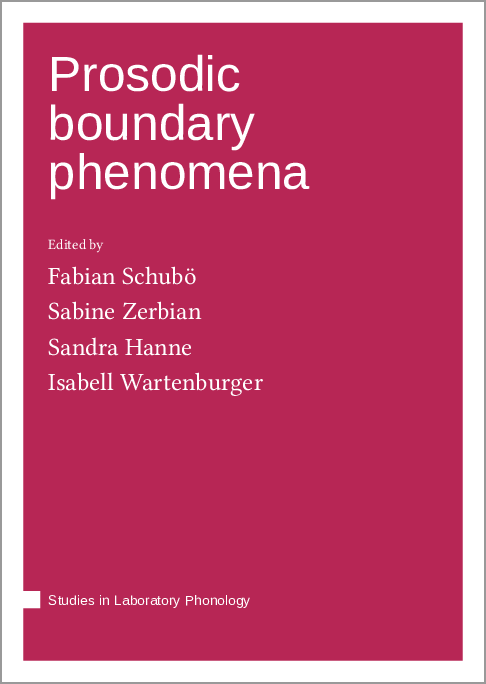In der letzten Zeit sind u.a. diese frei verfügbaren Titel erschienen:
Prosodic boundary phenomena
Fabian Schubö, Sabine Zerbian, Sandra Hanne & Isabell Wartenburger
https://langsci-press.org/catalog/book/379
https://doi.org/10.5281/zenodo.7777469
In spoken language comprehension, the hearer is faced with a more or less continuous stream of auditory information. Prosodic cues, such as pitch movement, pre-boundary lengthening, and pauses, incrementally help to organize the incoming stream of information into prosodic phrases, which often coincide with syntactic units. Prosody is hence central to spoken language comprehension and some models assume that the speaker produces prosody in a consistent and hierarchical fashion. While there is manifold empirical evidence that prosodic boundary cues are reliably and robustly produced and effectively guide spoken sentence comprehension across different populations and languages, the underlying mechanisms and the nature of the prosody-syntax interface still have not been identified sufficiently. This is also reflected in the fact that most models on sentence processing completely lack prosodic information.
This edited book volume is grounded in a workshop that was held in 2021 at the annual conference of the Deutsche Gesellschaft für Sprachwissenschaft (DGfS). The five chapters cover selected topics on the production and comprehension of prosodic cues in various populations and languages, all focusing in particular on processing of prosody at structurally relevant prosodic boundaries. Specifically, the book comprises cross-linguistic evidence as well as evidence from non-native listeners, infants, adults, and elderly speakers, highlighting the important role of prosody in both language production and comprehension.
Significance in language: a theory of semantics
Jim Feist
https://doi.org/10.4324/9781003259381
This book offers a unique perspective on meaning in language, broadening the scope of existing understanding of meaning by introducing a comprehensive and cohesive account of meaning that draws on a wide range of linguistic approaches.
The volume seeks to build up a complete picture of what meaning is, different types of meaning, and different ways of structuring the same meaning across myriad forms and varieties of language across such domains, such as everyday speech, advertising, humour, and academic writing. Supported by data from psycholinguistic and neurolinguistic research, the book combines different approaches from scholarship in semantics, including formalist, structuralist, cognitive, functionalist, and semiotics to demonstrate the ways in which meaning is expressed in words but also in word order and intonation. The book argues for a revised conceptualisation of meaning toward presenting a new perspective on semantics and its wider study in language and linguistic research.
This book will appeal to scholars interested in meaning in language in such fields as linguistics, semantics, and semiotics.
Words in Space and Time: A Historical Atlas of Language Politics in Modern Central Europe
Tomasz Kamusella
https://doi.org/10.7829/9789633864180
With forty-two extensively annotated maps, this atlas offers novel insights into the history and mechanics of how Central Europe’s languages have been made, unmade, and deployed for political action. The innovative combination of linguistics, history, and cartography makes a wealth of hard-to-reach knowledge readily available to both specialist and general readers. It combines information on languages, dialects, alphabets, religions, mass violence, or migrations over an extended period of time.
The story first focuses on Central Europe’s dialect continua, the emergence of states, and the spread of writing technology from the tenth century onward. Most maps concentrate on the last two centuries. The main storyline opens with the emergence of the Western European concept of the nation, in accord with which the ethnolinguistic nation-states of Italy and Germany were founded. In the Central European view, a “proper” nation is none other than the speech community of a single language. The Atlas aspires to help users make the intellectual leap of perceiving languages as products of human history and part of culture. Like states, nations, universities, towns, associations, art, beauty, religions, injustice, or atheism—languages are artefacts invented and shaped by individuals and their groups.


